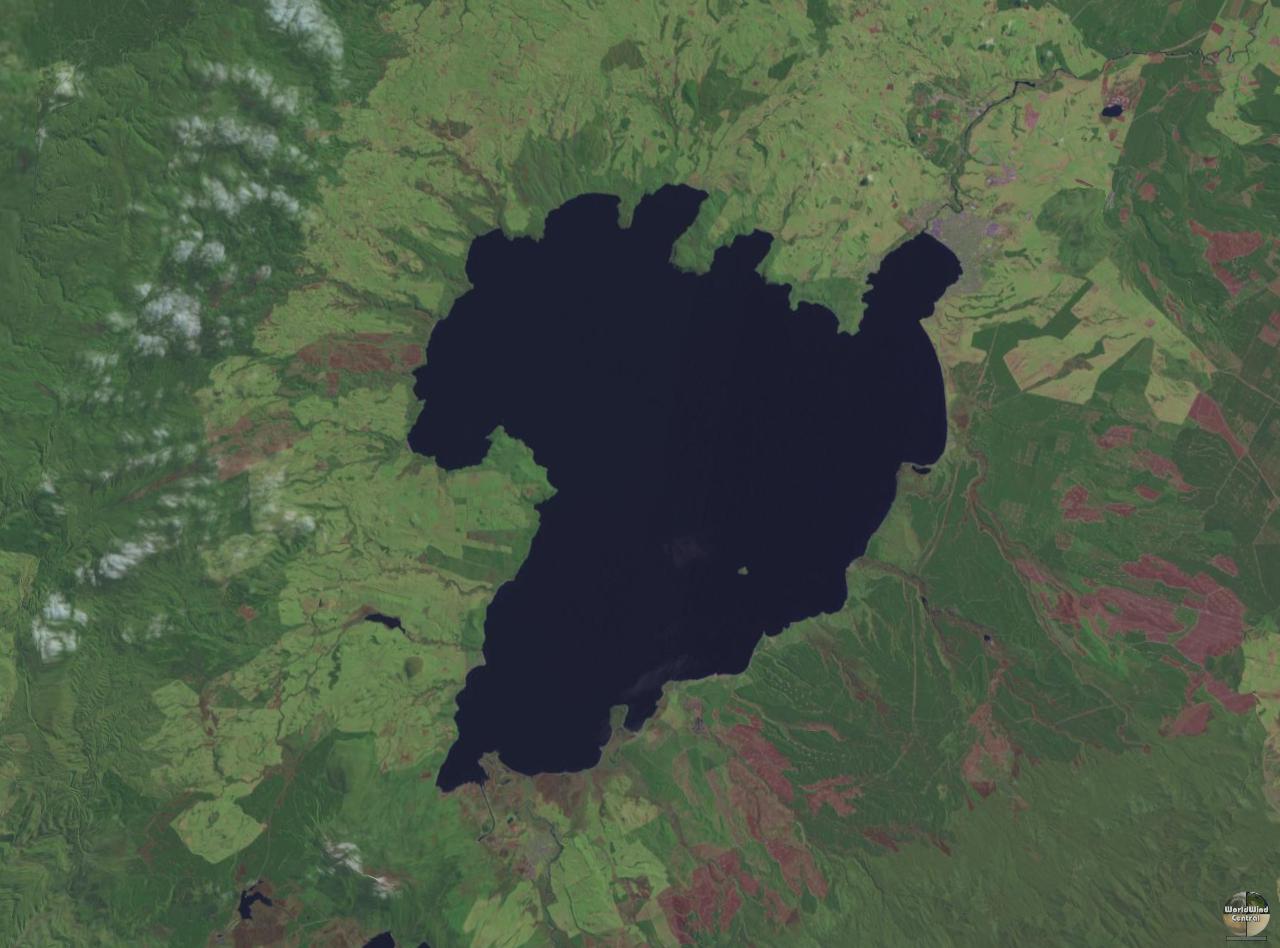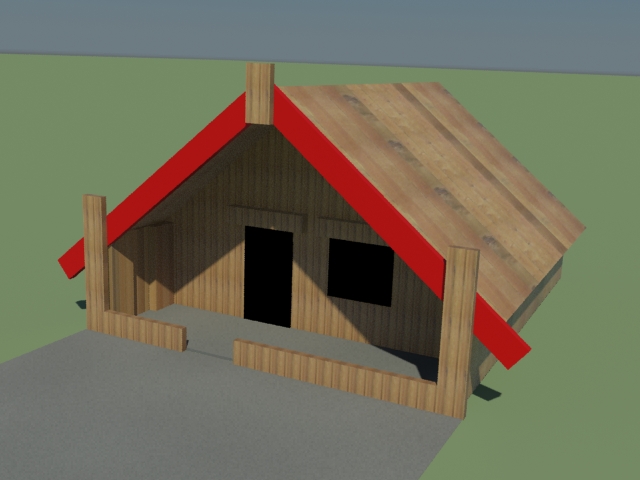|
Motutere, New Zealand
Motutere is a small township on the southeastern shore of Lake Taupō in New Zealand's Waikato region.Dowling, P. (ed.) (2004). ’’Reed New Zealand atlas’’. Auckland: Reed Publishing. It lies on Motutere Bay, close to the popular diving location, Te Poporo / Bulli Point, and approximately halfway between Taupō and Tūrangi, to both of which it is connected by SH1. In the 18th century, the township was the base of Te Rangi-tua-mātotoru, the paramount chief of Ngāti Tūwharetoa. Motutere is dominated by a camping site, one of the main spots for caravan camping along the shores of the lake. A popular short walking track, Waipehi Walk, begins at the settlement and offers views across the lake. " |
Lake Taupō
Lake Taupō (also spelled Taupo; or ) is a large crater lake in New Zealand's North Island, located in the caldera of Taupō Volcano. The lake is the namesake of the town of Taupō, which sits on a bay in the lake's northeastern shore. With a surface area of , it is the largest lake by surface area in New Zealand, and the second largest freshwater lake by surface area in geopolitical Oceania after Lake Murray in Papua New Guinea. Motutaiko Island lies in the southeastern area of the lake. Geography Lake Taupō has a perimeter of approximately and a maximum depth of . It is drained by the Waikato River (New Zealand's longest river), and its main tributaries are the Waitahanui River, the Tongariro River, and the Tauranga Taupō River. It is a noted trout fishery with stocks of introduced brown and rainbow trout. The level of the lake is controlled by Mercury Energy, the owner of the eight hydroelectric dams on the Waikato River downstream of Lake Taupō, using gates b ... [...More Info...] [...Related Items...] OR: [Wikipedia] [Google] [Baidu] |
Waikato
The Waikato () is a region of the upper North Island of New Zealand. It covers the Waikato District, Waipā District, Matamata-Piako District, South Waikato District and Hamilton City, as well as Hauraki, Coromandel Peninsula, the northern King Country, much of the Taupō District, and parts of the Rotorua Lakes District. It is governed by the Waikato Regional Council. The Waikato stretches from Coromandel Peninsula in the north, to the north-eastern slopes of Mount Ruapehu in the south, and spans the North Island from the west coast, through the Waikato and Hauraki to Coromandel Peninsula on the east coast. Broadly, the extent of the region is the Waikato River catchment. Other major catchments are those of the Waihou, Piako, Awakino and Mōkau rivers. The region is bounded by Auckland on the north, Bay of Plenty on the east, Hawke's Bay on the south-east, and Manawatū-Whanganui and Taranaki on the south. Waikato Region is the fourth largest region in the c ... [...More Info...] [...Related Items...] OR: [Wikipedia] [Google] [Baidu] |
Motutere Bay
{{geodis ...
Motutere may refer to one of several locations in New Zealand's Waikato Region: *Castle Rock (Waikato), a mountain which has the alternative Mãori name ''Motutere'' *Motutere, New Zealand, a township on the shore of Lake Taupõ ** Motutere Bay, an indentation in the shore of Lake Taupõ; see Motutere, New Zealand Motutere is a small township on the southeastern shore of Lake Taupō in New Zealand's Waikato region.Dowling, P. (ed.) (2004). ’’Reed New Zealand atlas’’. Auckland: Reed Publishing. It lies on Motutere Bay, close to the popular diving l ... [...More Info...] [...Related Items...] OR: [Wikipedia] [Google] [Baidu] |
Te Poporo / Bulli Point
Bulli Point (, officially gazetted as Te Pōporo / Bulli Point) is a point on Lake Taupō, in the central North Island of New Zealand. The point is a popular spot for rock jumping. Location Bulli Point sits in Motutere Bay on the eastern side of Lake Taupō. It lies close to State Highway 1, less than one kilometre east of Motutere. Naming The name ''Te Pōporo'' is a Te Reo Māori name taken from the pā that once stood on the hill above the point. It was one of several important pā located between Motutere and Hatepe. The pā may have been named after Pōporo, a Māori name for ''Solanum aviculare'' and ''Solanum laciniatum'', a local shrub with white to blue-purple flowers, and yellow to orange fruit, sometimes called bullibulli. A point on the western side of the lake, Te Poroporo Point, also contains a word for the same shrub, ''Poroporo''. The origin of the name ''Bulli Point'' is unclear. Toitū Te Whenua's New Zealand Gazetteer suggests it may be a contraction ... [...More Info...] [...Related Items...] OR: [Wikipedia] [Google] [Baidu] |
Taupō
Taupō (), sometimes written Taupo, is a town located in the central North Island of New Zealand. It is situated on the edge of Lake Taupō, which is the largest freshwater lake in New Zealand. Taupō was constituted as a borough in 1953. It has been the seat of Taupō District Council since the council was formed in 1989. Taupō is the largest urban area of the Taupō District, and the second-largest urban area in the Waikato, Waikato region, behind Hamilton, New Zealand, Hamilton. It has a population of approximately Taupō is known for its natural beauty, with the surrounding area offering a range of outdoor recreational activities such as hiking, fishing, skiing, and water sports. Visitors can also enjoy a variety of attractions, including the Wairakei Power Station, Huka Falls, and the Tongariro National Park. Naming The name ''Taupō'' is from the Māori language and is a shortened version of ''Taupō-nui-a-Tia''. The longer name was first given to the cliff at Pākā B ... [...More Info...] [...Related Items...] OR: [Wikipedia] [Google] [Baidu] |
Tūrangi
Tūrangi is a small town on the west bank of the Tongariro River, 50 kilometres south-west of Taupō on the North Island Volcanic Plateau of New Zealand. It was built to accommodate the workers associated with the Tongariro Power Scheme, Tongariro hydro-electric power development project and their families. The town was designed to remain as a small servicing centre for the exotic forest plantations south of Lake Taupō and for tourists. It is well known for its trout fishing and calls itself "the trout fishing capital of the world". The major Māori people, Māori ''hapū'' (tribe) of the Tūrangi area is Ngāti Tūrangitukua. Geography The Tūrangi area covers some 2273 km², and is located close to the edge of the Kaimanawa Ranges and ten kilometres north of the stretch of New Zealand State Highway 1, State Highway 1 known as the ''Desert Road''. The streets around Tūrangi in autumn are lined with "brilliant" foliage. Built on the banks of the Tongariro River, Tūran ... [...More Info...] [...Related Items...] OR: [Wikipedia] [Google] [Baidu] |
State Highway 1 (New Zealand)
State Highway 1 (SH 1) is the longest and most significant road in the New Zealand road network, running the length of both main islands. It appears on road maps as SH 1 and on road signs as a white number 1 on a red shield, but it has the official designations SH 1N in the North Island, SH 1S in the South Island. SH 1 is long, in the North Island and in the South Island. Since 2010 new roads have reduced the length from . For the majority of its length it is a two-lane single carriageway, with at-grade intersections and property accesses, in both rural and urban areas. These sections have some passing lanes. Around of SH 1 is of motorway or expressway standard : in the North Island and in the South Island. Route North Island (SH 1N) SH 1 starts at Cape Reinga, at the northwestern tip of the Aupōuri Peninsula, and since April 2010 has been sealed (mainly with either chipseal or asphalt) for its entire length. From Waitiki Landing south of Cape Reinga, SH 1 t ... [...More Info...] [...Related Items...] OR: [Wikipedia] [Google] [Baidu] |
Te Rangi-tua-mātotoru
Te Rangi-tua-mātotoru was an 18th-century Māori people, Māori ''rangatira'' and tohunga of the Ngāti Te Rangiita hapū and ''ariki'' (paramount chieftain) of the Ngāti Tūwharetoa iwi of the region around Lake Taupō, New Zealand. He built three great wharenui (meeting houses) for different sections of Ngāti Tūwharetoa. When the Tūwharetoa chieftain Tutakaroa attacked Te Rangi-tua-mātotoru’s allies in Ngāti Tahu, he summoned allies from Te Arawa to attack Tutakaroa at Whakaohokau, but had second thoughts about the venture and arranged a peace before Te Arawa could wreak havoc. He sent a force to help Te Uamairangi from the Ngāti Te Upokoiri ''hapū'' of Ngāti Kahungunu escape to Whakatane after he was defeated in a bid for control of Ngāti Kahungunu. In his old age, he negotiated the peace which ended the Tūhoe-Ngāti Tūwharetoa War. After his death, he was eventually succeeded by Herea Te Heuheu Tukino I. He played an important role in Ngāti Tūwharetoa as the m ... [...More Info...] [...Related Items...] OR: [Wikipedia] [Google] [Baidu] |



